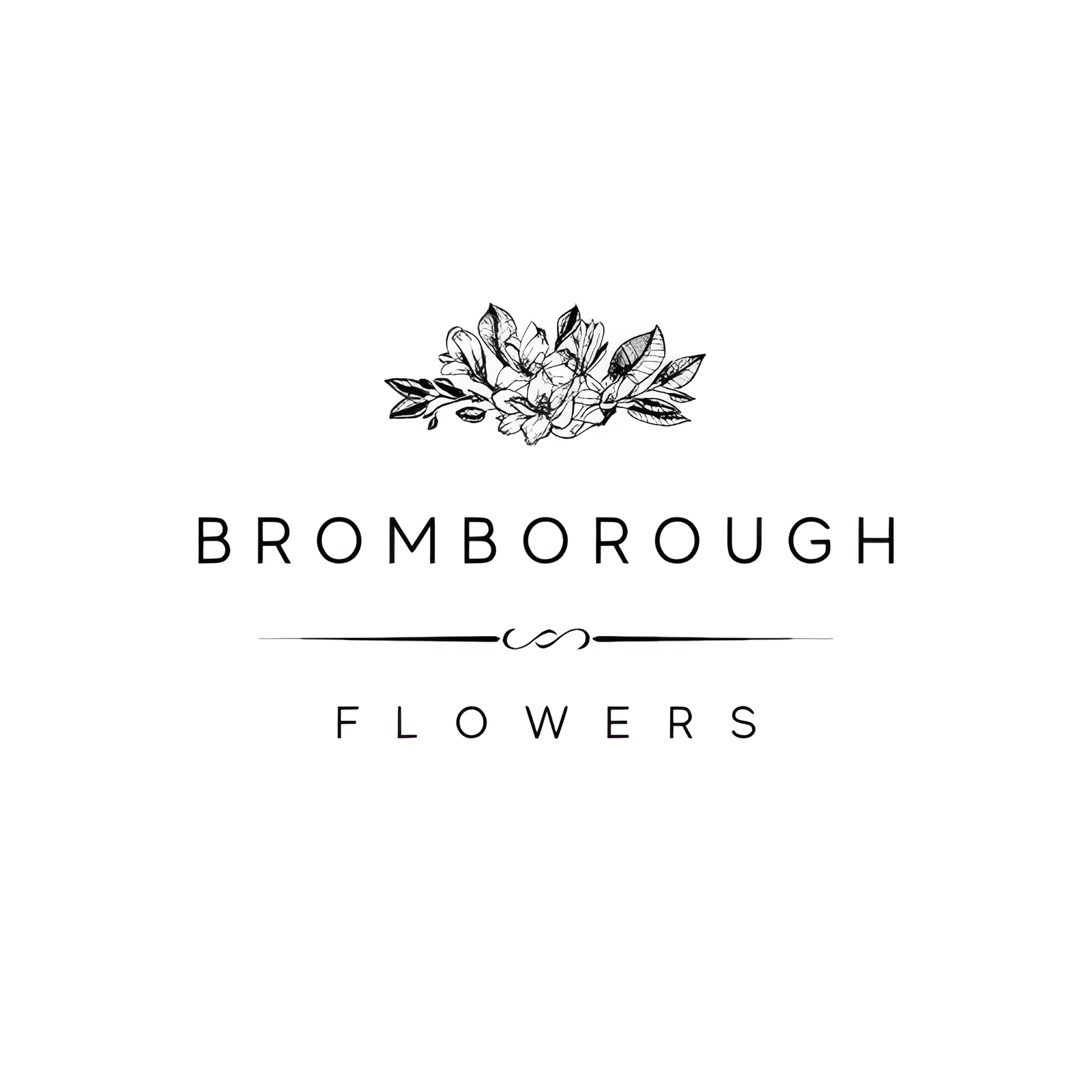When planning a wedding, the selection of flowers plays an essential role in setting the tone and ambiance of the event, and caladiums offer a unique and enchanting option. With their vibrant, heart-shaped leaves and a wide array of shades, caladiums can transform any venue into a lush, romantic landscape. Beyond their visual appeal, these plants thrive in warm, shaded environments, making them an excellent choice for spring and summer ceremonies. The cultural significance of caladiums, symbolizing love and devotion, adds another layer of meaning to their inclusion. But what makes them particularly suited for weddings?
Flower Overview

Caladiums, with their vibrant and colorful heart-shaped leaves, are a popular choice for wedding flowers due to their romantic appeal and easy upkeep. Known for their striking patterns and a variety of shades, including pink, white, and green, Caladiums add a unique and lively touch to any wedding arrangement. Their tropical nature makes them especially suited for creating a lush and vibrant atmosphere that complements both indoor and outdoor wedding settings.
For the bride seeking to incorporate a blend of elegance and exotic charm, Caladiums serve as an ideal option. These versatile plants thrive in shaded areas, offering flexibility in decoration regardless of the venue. Their leaves can change color based on light exposure, providing a dynamic and ever-evolving visual display that adds intrigue and beauty to wedding decorations.
Caladiums are not just visually appealing but also practical. Their easy care ensures that they remain fresh and vibrant throughout the wedding day, reducing the stress of floral upkeep. Whether used in bouquets, centerpieces, or general decorations, Caladiums offer a blend of aesthetic appeal and practicality, making them a favored choice for brides aiming for a memorable and picturesque wedding.
Physical Description
Known for their striking heart-shaped leaves, these vibrant plants display a rich palette of colors, including pink, red, green, and white. Caladiums are celebrated for their unique and intricate leaf characteristics, which often feature contrasting veins and variegated patterns. These leaves are thin and delicate, adding an elegant touch to any floral arrangement or garden display.
Caladiums typically grow from tubers, reaching heights of 12-24 inches, making them a versatile choice for various decorative purposes. Their growth patterns are well-suited to environments with warm soil and consistent moisture, thriving particularly well in shaded areas. This adaptability allows them to flourish in conditions that might be challenging for other plants, adding to their appeal.
An important consideration when choosing Caladiums is their toxicity concerns. While these plants can enhance the aesthetic of a wedding setting, they are toxic if ingested and can cause skin irritation. This makes them potentially harmful to pets such as dogs, cats, and horses. Hence, caution should be exercised when incorporating Caladiums into environments where animals or children may be present.
Available Colour Varieties
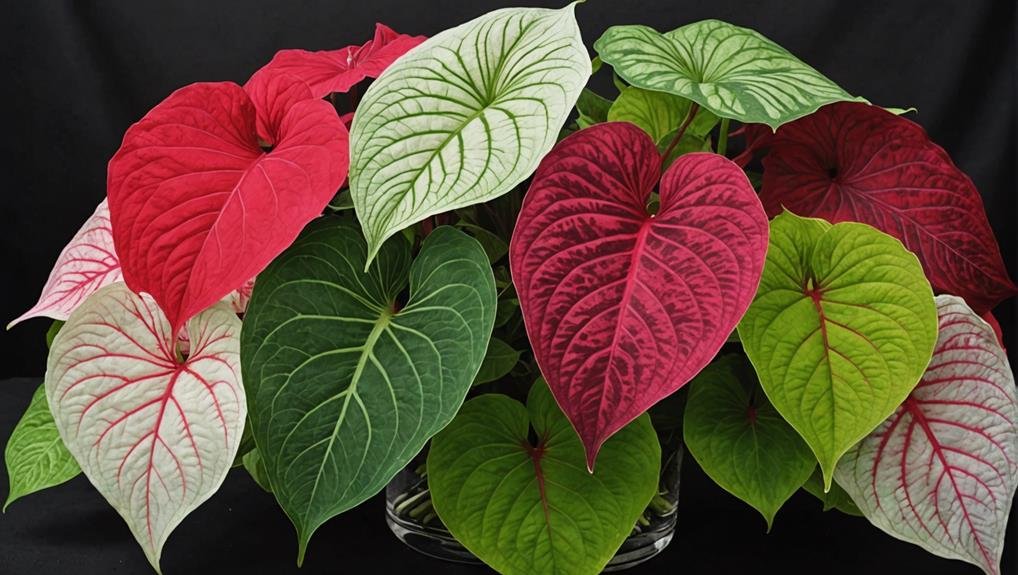
Among the diverse options available, the color varieties of Caladiums offer a stunning array of hues that can elevate the visual appeal of any wedding floral arrangement. These plants are renowned for their enchanting color combinations, featuring shades such as deep pink, white, and green. Popular choices like Blushing Bride, Apple Blossom, Berries N Burgundy, and Bombshell showcase a spectrum of shade variations that cater to different aesthetic preferences.
The leaves of Caladiums are particularly remarkable for their unique patterns, which can shift based on light exposure, adding a dynamic element to floral designs. This characteristic makes them an excellent choice for creating attention-grabbing and versatile wedding arrangements. Each variety brings its own distinct charm, ensuring that there is a Caladium to suit any theme or color palette.
For instance, varieties like Ballet Slippers and Allure provide a range of colors from soft pastels to vibrant hues, making them adaptable to both traditional and contemporary wedding styles. These distinctive features not only enhance the beauty of the floral setup but also introduce a layer of sophistication and elegance, making Caladiums a preferred option for special events.
Latin Name and Taxonomy
Understanding the botanical background of Caladiums, specifically their Latin name and taxonomy, further enriches our appreciation of these versatile plants. The Latin name for Caladium is *Caladium hortulanum*, and it belongs to the Araceae family. This classification places Caladiums among a diverse group of flowering plants known for their intriguing foliage and unique forms.
Caladiums are frequently referred to as 'elephant ear' or 'angel wings' due to their large, heart-shaped leaves. The diversity in leaf patterns and colors makes them a popular choice for both gardens and indoor spaces. The taxonomy of Caladiums encompasses various cultivars, each offering a distinct array of visual appeal. This extensive leaf diversity is a result of meticulous cultivar selection, allowing for a broad spectrum of aesthetic options.
Significant advancements in breeding have led to an increase in genetic variation within the species. Hybridization trends continue to evolve, contributing to the ongoing development of new and unique cultivars.
- Leaf diversity and cultivar selection: The broad range of leaf patterns and colors available.
- Genetic variation and breeding advancements: Enhanced through selective breeding.
- Species distribution and hybridization trends: Influencing the development of new and unique cultivars.
These factors collectively underscore the botanical richness of Caladiums, making them a valued addition to any floral arrangement.
Geographical Origins
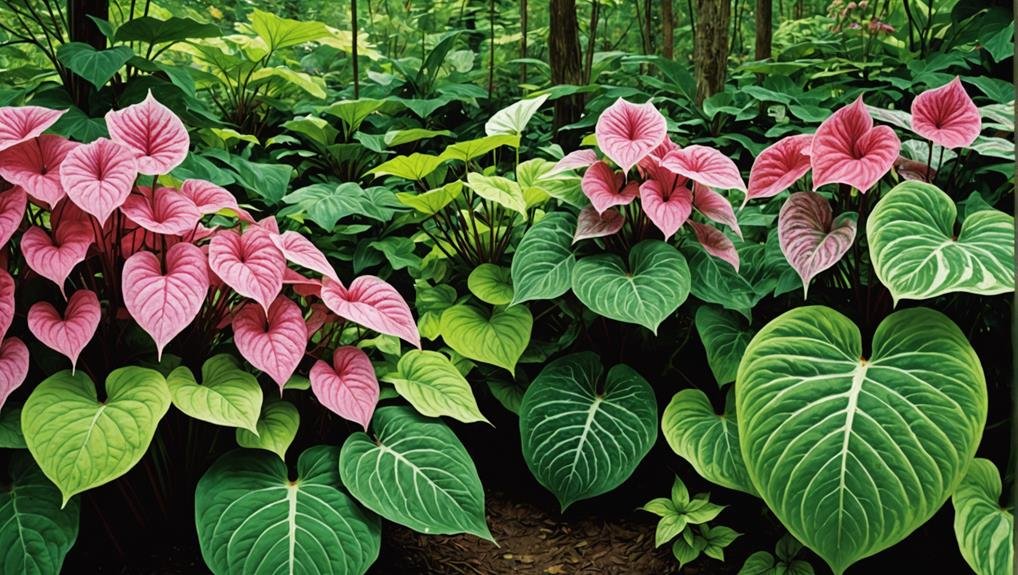
Caladium plants trace their origins to the tropical regions of South America, particularly Brazil and Peru. These areas provide the ideal natural habitat for caladiums, characterized by warm, humid climates and rich, well-drained soils. The plant distribution of caladiums is primarily confined to tropical and subtropical zones, where they flourish in the understory of rainforests, benefiting from the dappled sunlight and consistent moisture.
| Aspect | Details |
|---|---|
| Origin | South America |
| Key Locations | Brazil, Peru |
| Natural Habitat | Rainforest understory |
| Climate Requirements | Warm and humid |
| Family | Araceae |
The ecological impact of caladiums in their native regions is significant. As part of the diverse Araceae family, which includes other popular plants like peace lilies and philodendrons, caladiums contribute to the biodiversity and complexity of tropical ecosystems. Their broad, colorful leaves provide a unique microhabitat for various insects and other small organisms, playing an essential role in the local ecological balance.
Cultivated for centuries, caladiums have been developed into numerous cultivars and varieties, enhancing their ornamental appeal. This extensive cultivation has allowed them to spread beyond their native range, making them popular additions to gardens and wedding arrangements worldwide.
Season Availability
The seasonal availability of caladiums is mainly during the spring and summer months. These vibrant and versatile plants thrive in warm weather, making them an excellent choice for weddings held during these seasons. Availability may vary depending on the specific variety of caladium selected for your floral arrangements, so it is advisable to plan ahead and place your order in advance to maximize their availability for your special day.
To enhance the use of caladiums in your wedding arrangements, consider the following:
- Planting tips, gardening tricks: Knowing the right planting tips and gardening tricks can help you grow caladiums successfully if you are sourcing them locally. This includes understanding when to plant them and how to care for them during their peak season.
- Seasonal care, ideal conditions: Caladiums require specific seasonal care and ideal conditions to flourish. They thrive in warm, humid environments with indirect sunlight, which makes them perfect for summertime weddings.
- Bouquet ideas, centerpiece creativity: The broad, colorful leaves of caladiums offer unique bouquet ideas and centerpiece creativity. These plants can add a touch of elegance and vibrant color to any wedding arrangement, creating memorable floral displays.
Growing Conditions
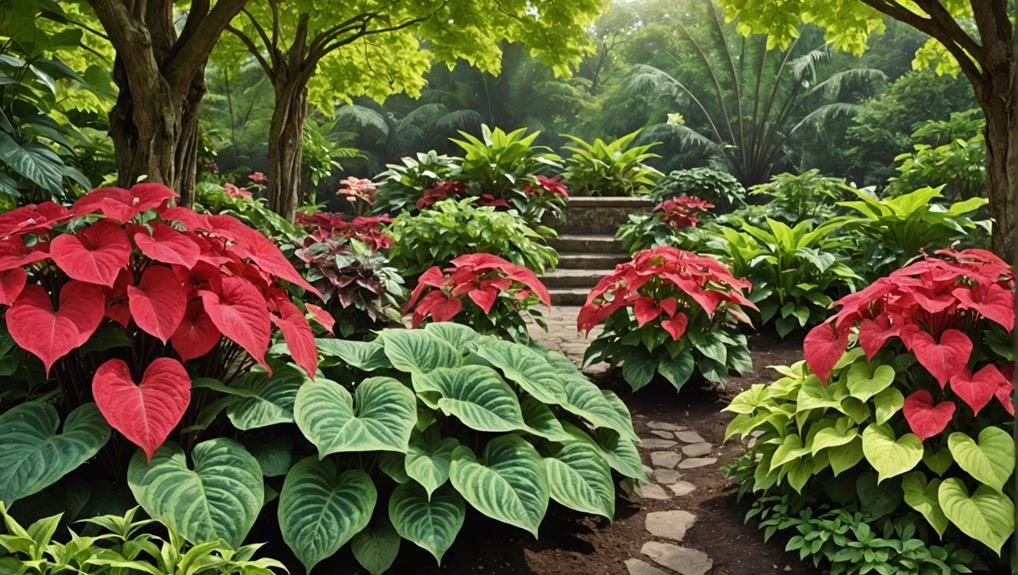
To ensure the caladiums in your wedding arrangements flourish beautifully, it's crucial to understand their specific growing conditions. Caladiums thrive in warm soil conditions, which is essential to their best growth and emergence. Ensuring soil health is vital; these plants prefer rich, well-draining soil to support their development. Their temperature preferences lean towards warmer climates, ideally within USDA hardiness zones 9-12 and heat zones 4-11.
In terms of sunlight exposure, caladiums exhibit impressive shade tolerance, thriving best in partially shaded areas. However, they can also tolerate some sun exposure, making them versatile for various light conditions. Balancing this aspect is essential to maintaining their vibrant foliage, which adds to the allure of wedding arrangements.
Moisture needs are another important factor; regular watering is necessary to keep the soil consistently moist but not waterlogged. This helps sustain the plant's health and longevity, especially when planted in spring or mild winters.
Notably, caladiums present toxicity risks, being harmful if ingested and potentially causing skin irritation. Hence, they are unsuitable for households with pets or small children, necessitating careful handling and placement in wedding décor.
Cultural Significance
Embodying symbols of love and devotion, caladiums hold significant cultural importance in wedding traditions. Their heart-shaped leaves are universally recognized as a symbol of affection, making them an ideal choice for romantic celebrations.
Across various cultures, caladiums are more than just decorative elements; they carry profound symbolic traditions that enhance their allure in matrimonial ceremonies.
Incorporating caladiums into wedding rituals is often steeped in superstitions and beliefs. In some societies, these vibrant plants are thought to bring good luck and prosperity to the newlyweds. The belief that caladiums can foster a harmonious and prosperous marriage is deeply ingrained in several cultural customs, further elevating their status in wedding planning.
The cultural significance of caladiums can be summarized as follows:
- Symbolic Traditions: The heart-shaped leaves symbolize love and devotion, making them a popular choice for weddings.
- Superstitions and Beliefs: In certain cultures, caladiums are believed to bring good fortune and prosperity to the couple.
- Cultural Customs: The integration of caladiums in wedding ceremonies reflects a rich tapestry of traditions and beliefs that celebrate love and unity.
These aspects make caladiums a meaningful and cherished addition to wedding celebrations worldwide.
Typical Use in Weddings
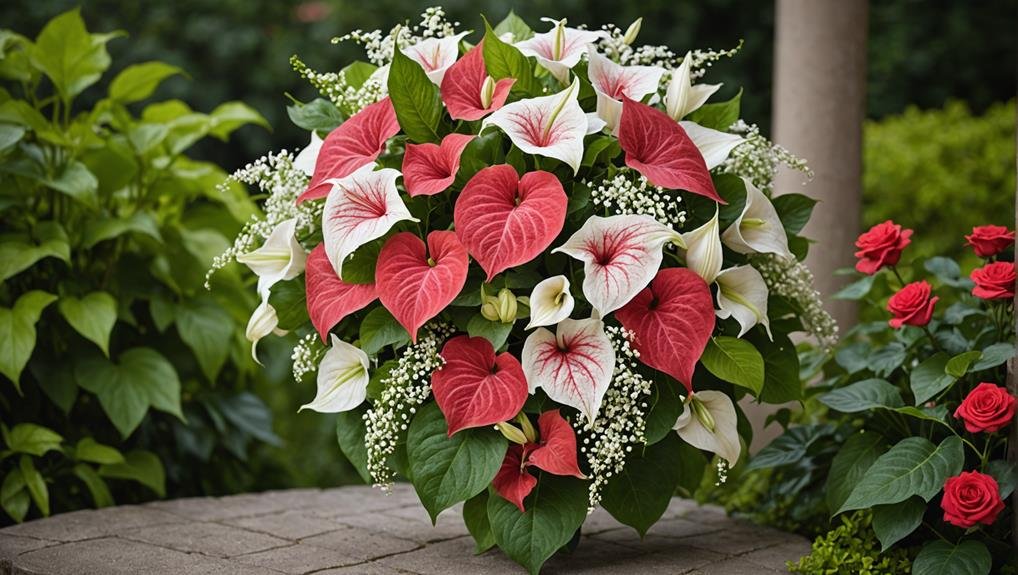
Caladiums, with their vibrant hues and distinctive leaf shapes, are a popular choice for adding grace and refinement to wedding floral arrangements. These eye-catching plants are often incorporated in wedding bouquets, centerpieces, and other floral decorations, imbuing any wedding venue with a captivating visual allure. Varieties like the 'Blushing Bride' can seamlessly complement a variety of wedding themes, from romantic garden settings to lively tropical ceremonies.
Integrating caladiums into wedding decor offers numerous decorative possibilities. Artistic arrangements can be crafted by combining caladiums with other blooms and foliage, resulting in unique combinations that stand out. Their bold foliage can bring an invigorating twist to traditional floral designs, making them ideal for couples seeking to personalize their wedding aesthetics.
Whether used indoors or outdoors, caladiums enhance the overall atmosphere of the wedding venue. Their versatility allows them to be incorporated into various wedding elements, such as aisle decorations, altar arrangements, and reception decor. Additionally, caladiums' easy maintenance guarantees they remain vibrant throughout the event, offering lasting beauty from the ceremony to the reception.
Therefore, caladiums are a favored choice for creating unforgettable and visually stunning wedding experiences.
Alternative Flower Types
When looking for alternative flower types to enhance wedding floral arrangements, consider incorporating Begonias, Coleus, and other distinctive plants for a similarly enchanting effect. These alternative plants offer unique arrangements, colorful options, and versatile choices that can elevate the aesthetic of any wedding decor.
Begonias are an excellent choice due to their wide range of colors and shapes. They provide endless possibilities for creating versatile and visually appealing arrangements, making them a favored option for wedding florists.
Coleus plants, on the other hand, are renowned for their vibrant hues and varied leaf patterns. These attributes make Coleus an eye-catching and unique option for bouquets and centerpieces.
To further enrich your wedding floral designs, consider mixing different foliage plants such as Ferns or Hostas. These additions can create lush, textured arrangements that add depth and visual interest.
- Rex Begonias: Known for their exotic leaf shapes and striking colors, perfect for unique arrangements.
- Persian Shield: Offers metallic hues that add a mesmerizing touch to any floral display.
- Ferns and Hostas: Ideal for adding texture and lushness to wedding decor.
